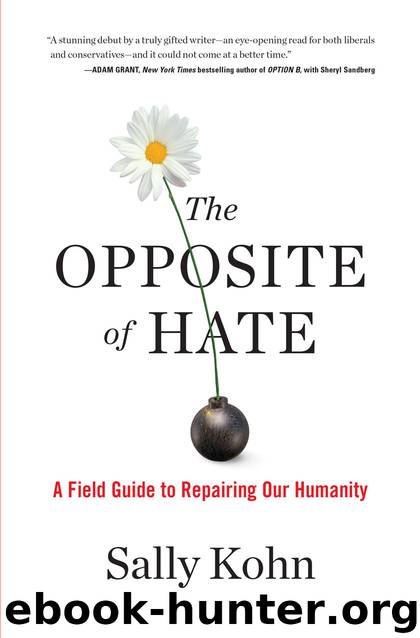The Opposite of Hate: A Field Guide to Repairing Our Humanity by Sally Kohn

Author:Sally Kohn [Kohn, Sally]
Language: eng
Format: azw3, epub
Publisher: Algonquin Books
Published: 2018-04-10T04:00:00+00:00
Five
When Hate Becomes Pandemic: The Genocide
Forgiveness is not forgetting. Forgiveness is freedom from hate.
—Valarie Kaur
When I step out of the airport in Kigali, Rwanda, in November 2016, the air smells like burning trash. I’m told that if I’d been there twenty-two years ago, it would have smelled like rotting flesh.
Of course, as an American, I wouldn’t have been there then—every embassy worker from the US and every other country’s diplomats, and most of the rest of the foreigners in the country, fled. During a period of one hundred days in 1994, Rwanda’s Hutu majority killed approximately eight hundred thousand of the nation’s Tutsi minority. The Rwandan genocide is, in fact, often described as the fastest genocide in world history—a breathtaking average of eight thousand people were murdered every day, many by their own friends and neighbors. Thousands and thousands of ordinary people—it is estimated that at least two hundred thousand Hutus participated in the genocide—became, in the words of genocide scholar Daniel Goldhagen, “willing executioners.” This is what happens when hate, like wildfire, is deliberately spread nationwide.
When evil reaches a massive, pandemic scale, most of those who are not the direct victims just look the other way. It’s as though if genocide isn’t happening to us personally, we feel bad, but we don’t feel connected—like it has nothing to do with us, our history, our hate. Too often, especially those of us in the West think genocide is some unusual thing that only happens to unusual people in unusual places. We think it can never happen to us, or because of us. How wrong we are.
When the Rwandan genocide began, John Giraneza, a Tutsi, was twenty years old. John grew up in the Bugesera District, in eastern Rwanda, in a village about an hour’s drive from Kigali, the country’s capital. The area around his village is called the Rweru sector, which is a lush valley named for Lake Rweru, which straddles the border with Burundi. Rural Rwanda is a study in stark contrasts; lush green avocado, mango, and citrus trees sprout in clusters like mirages out of an otherwise relentless topography of dirt and dust. I drive to John’s village with my guide Solange Uwera, a young Rwandan woman with a heap of braids, worn sometimes on top of her head, sometimes cascading down her back. When we pass the villages on the way to Bugesera, groups of tiny children are running around in the fields and through the streets. I notice that all the boys and girls have their heads shaved. It’s expensive to care for hair in Rwanda. Solange’s braids are a luxury.
Eventually, our driver turns off the main road and we bump along a dirt one for several miles, passing lines of women in colorful kente-fabric wrap skirts and T-shirts, large nylon sacks balanced on their heads. They are probably carrying beans or rice, Solange tells me. One of the women has an extra cloth tied around her waist, and I can see the head of a baby just peeking out the back and gently bumping up and down as she walks.
Download
The Opposite of Hate: A Field Guide to Repairing Our Humanity by Sally Kohn.epub
This site does not store any files on its server. We only index and link to content provided by other sites. Please contact the content providers to delete copyright contents if any and email us, we'll remove relevant links or contents immediately.
| Anthropology | Archaeology |
| Philosophy | Politics & Government |
| Social Sciences | Sociology |
| Women's Studies |
Cecilia; Or, Memoirs of an Heiress — Volume 1 by Fanny Burney(32436)
Cecilia; Or, Memoirs of an Heiress — Volume 2 by Fanny Burney(31872)
Cecilia; Or, Memoirs of an Heiress — Volume 3 by Fanny Burney(31857)
The Great Music City by Andrea Baker(31372)
We're Going to Need More Wine by Gabrielle Union(18970)
All the Missing Girls by Megan Miranda(15583)
Pimp by Iceberg Slim(14397)
Bombshells: Glamour Girls of a Lifetime by Sullivan Steve(13977)
Talking to Strangers by Malcolm Gladwell(13225)
Norse Mythology by Gaiman Neil(13210)
Fifty Shades Freed by E L James(13158)
For the Love of Europe by Rick Steves(13036)
Mindhunter: Inside the FBI's Elite Serial Crime Unit by John E. Douglas & Mark Olshaker(9206)
Crazy Rich Asians by Kevin Kwan(9170)
The Lost Art of Listening by Michael P. Nichols(7409)
Enlightenment Now: The Case for Reason, Science, Humanism, and Progress by Steven Pinker(7238)
The Four Agreements by Don Miguel Ruiz(6636)
Bad Blood by John Carreyrou(6554)
Weapons of Math Destruction by Cathy O'Neil(6148)
